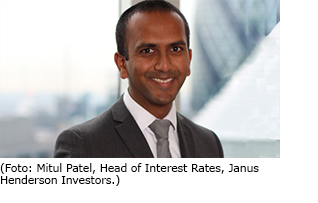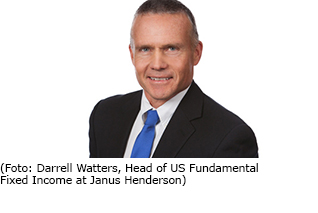
Janus Henderson: US rate hike as expected – but watch inflation
The US Federal Reserve raised its benchmark interest rates by a quarter of a percentage point, to a target range of 1.25-1.50%. Mitul Patel, Head of Interest Rates, and Darrell Watters, Head of US Fundamental Fixed Income, share their thoughts on the implications and what’s to come in 2018.
15.12.2017 | 10:50 Uhr
 Mitul Patel, Head of Interest Rates
Mitul Patel, Head of Interest Rates
As expected, the US Federal Reserve (Fed) raised interest rates to 1.25-1.50%. The median estimate for interest rates at the end of 2018 and 2019 was left unchanged, however, the 2020 estimate shifted to a level higher, suggesting the need for contractionary monetary policy at that point.
Growth estimates increased sizeably, reflecting the likelihood of fiscal stimulus being delivered by the Trump administration. Unemployment forecasts were lowered correspondingly, to further below the Fed’s estimate for what was sustainable in the longer run. Inflation forecasts showed little change, however, suggesting that the Fed did not expect higher growth and lower unemployment to lead to an intensification of inflationary pressures and therefore did not require tighter monetary policy than previously forecast.
The US Treasury market rallied in response, led by shorter dated bonds, as the market lowered the expected path of interest rates. Implicit within the Federal Open Market Committee (FOMC)’s forecasts is an expectation that productivity improves from here. If this proves not to be the case, the fiscal stimulus may lead to much bigger falls in the unemployment rate than the Fed forecasts, which may lead to higher inflation in the future. This also, however, remains dependent on the Phillips Curve reasserting itself, with lower unemployment rates leading to higher wage pressures. The Fed is likely to continue assessing policy one quarter at a time, although high turnover on the FOMC remains a risk that policy shifts in an unforeseen way.
The market currently assigns around a 70% chance that interest rates move higher in March, with a total of two hikes for the year. The pricing is probably fair for now and, although the market has persistently underpriced the Fed rate hiking cycle, it is likely to require more positive news on inflation to materially reprice the path of interest rates higher. Darrell Watters, Head of US Fundamental Fixed Income
Darrell Watters, Head of US Fundamental Fixed Income
The Fed raised its target benchmark rate by 25 basis points (bp) on Wednesday. This was the central bank’s third interest rate hike in 2017 and the fifth in its post-2008 tightening cycle. The increase puts the Fed’s target rate range between 1.25% and 1.50%. The Fed lifted its forecast for gross domestic product (GDP) – citing tax reform as one of the drivers – lowered its estimate for unemployment, and left its inflation forecast unchanged. Markets generally took the well-telegraphed hike in their stride. However, Treasury yields rallied, continuing the morning’s reaction to soft inflation data, as investors expressed their comfort with the central bank’s unchanged tightening expectations for 2018.
Even with tax reform, we believe economic growth and inflation will remain tepid next year, leading us to expect just two rate hikes in 2018. While unemployment is at its lowest level in more than 15 years, significant upward pricing pressures are still lacking. Demographics, globalisation, automation, and e-commerce are all deflationary forces, as are continued efficiency gains in shale extraction. Tax reform could also be deflationary, depending on whether companies opt to apply refunds toward price cuts or capital expenditures. Moreover, wage pressures remain soft. While unexpected inflation would be a catalyst for higher rates in 2018, we anticipate the aforementioned forces will keep it in check.
In our view, the biggest risk to the rate market, as well as the US economy, is the possibility of the Fed adopting a more aggressive tightening path. Fed Chair, Janet Yellen, has previously cautioned the market that more rate increases are necessary in order to prepare for the next recession. Hiking three times or faster than the market expects in 2018 when the economy isn’t strong enough to handle it could result in policy error, an inverted Treasury curve, and dramatic disruption in the rates market.
Our base case, however, is that the lower-for-longer environment we witnessed in 2017 will persist. The nomination of Jerome Powell as the next Fed Chair portends continuity in the central bank’s measured pace to both raising interest rates and balance sheet reduction, which should be favourable for markets. Yellen indicated that the Fed is willing to resume asset purchases to maintain stability, if necessary. The market’s assurance that the ‘Fed put’ remains suggests that any monetary tightening in 2018 will put only marginal upward pressure on Treasury yields.
We anticipate a sustained flattening of the yield curve, but we don’t think this is indicative of an imminent recession. The Fed’s emphasis on normalising rates will continue to put modest upward pressure on the front end of the curve, while ultra-low and negative yields globally should continue to foster demand for US rates and keep longer-dated Treasury yields range-bound.



Diesen Beitrag teilen: